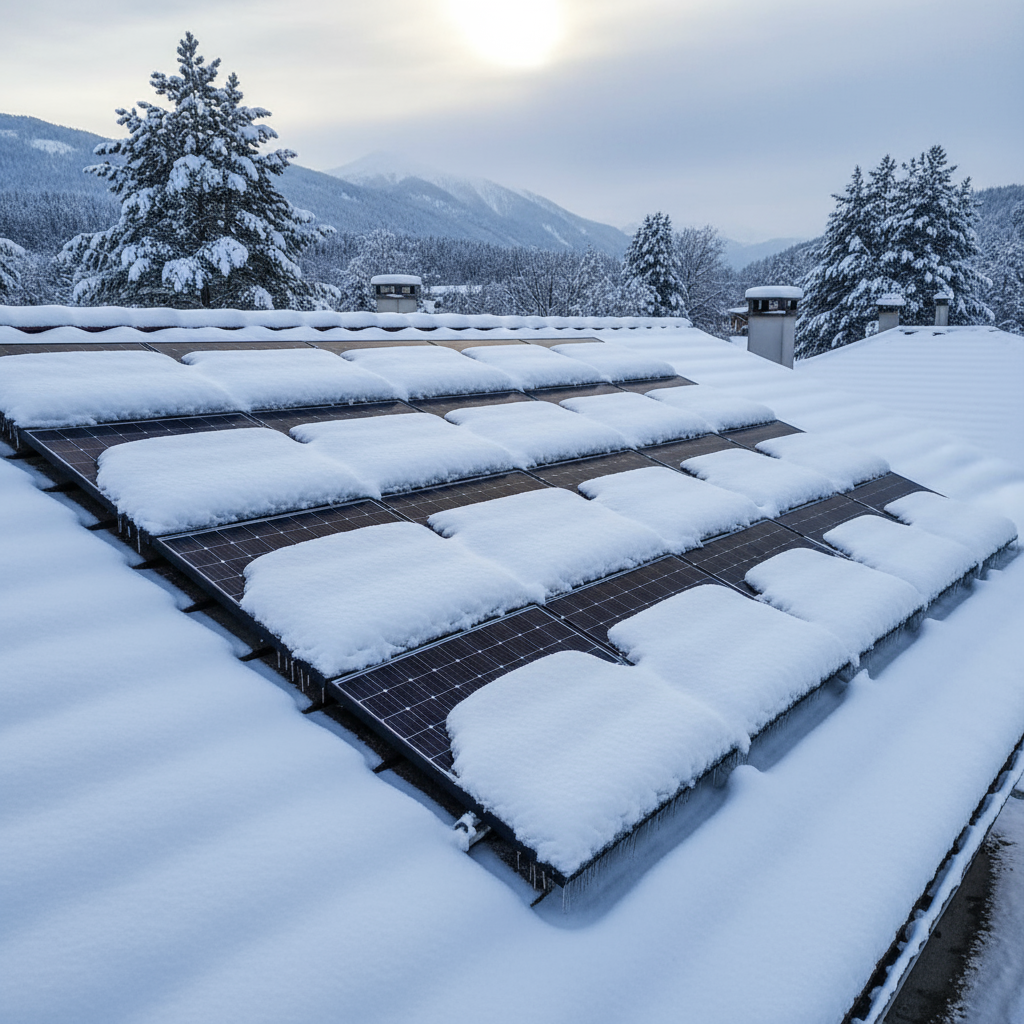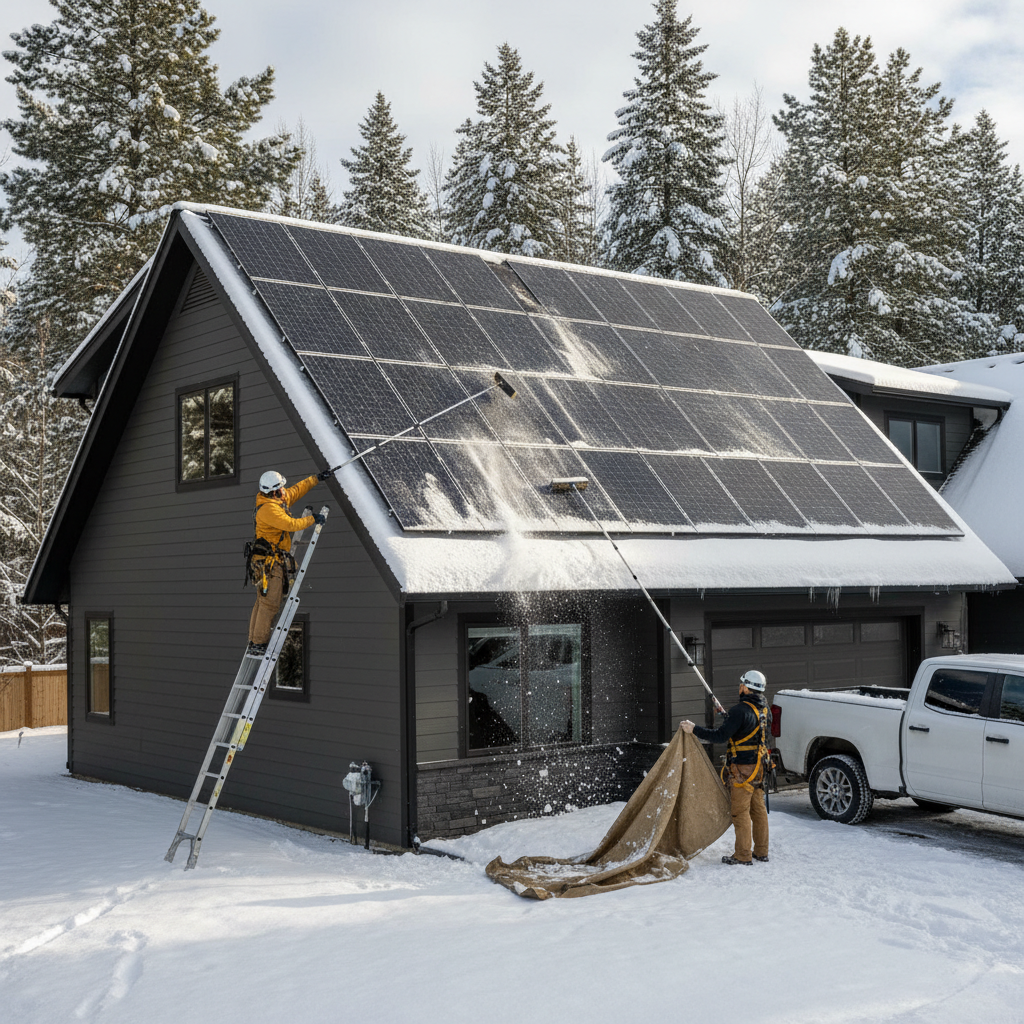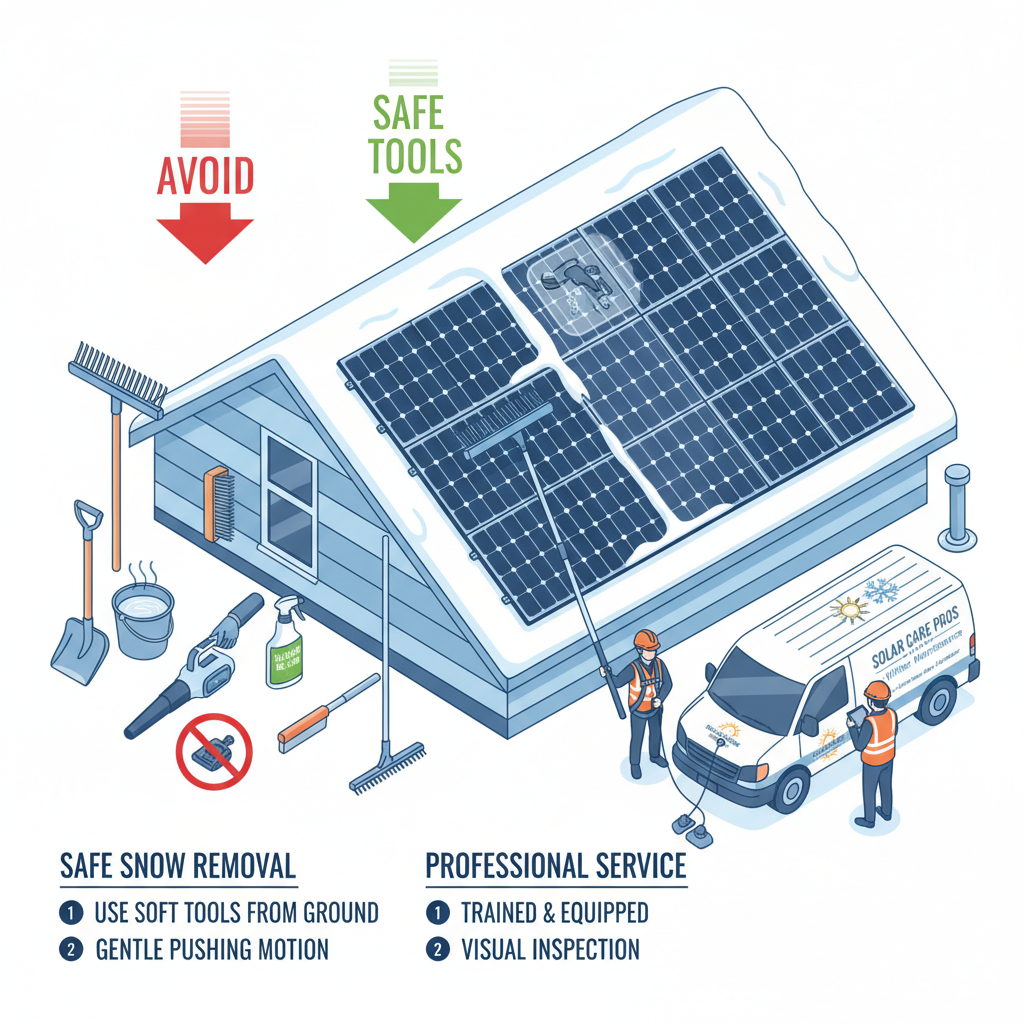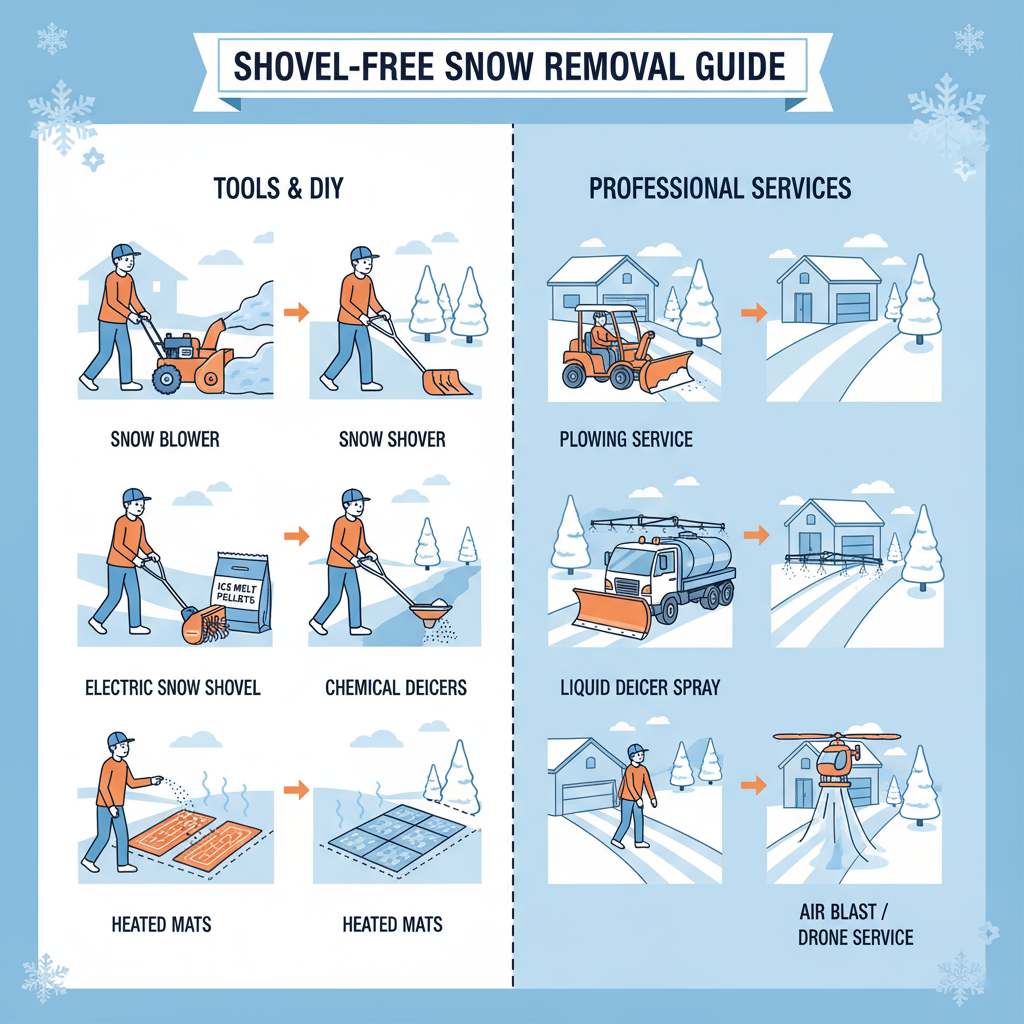TL;DR
- Snow rarely needs manual removal from solar panels due to their design and tilt.
- Use a decision matrix based on snow depth, panel tilt, and weather forecast.
- Always prioritize safety and use proper tools like solar snow rakes.
- Professional services are recommended for steep roofs or heavy snow.
Winter can turn a rooftop solar array into a beautiful snowy scene, but it also raises an important question for homeowners: should you remove snow from your solar panels, and if so, how? This guide explores how snow affects panel performance, when (and when not) to intervene, and the safest techniques for clearing snow without damaging your investment. It also links to our Contact page if you’d rather leave snow removal to professionals.
 Figure 1: Solar panels accumulating snow on a residential roof
Figure 1: Solar panels accumulating snow on a residential roof
How Snow Affects Solar Panels
Solar panels are designed to withstand harsh winter weather. Modern panels undergo mechanical loading tests that simulate heavy snow loads; most residential panels are rated to handle at least 5,000 Pascals of pressure, which equates to about 2-4 feet of snow depending on its density[1]. In practice, a light dusting of snow usually has little impact on production because wind and sun quickly clear the array, and sunlight can still scatter through thin layers[2]. Heavy accumulations, however, block light entirely and prevent generation until they melt off[3].
Snow can also benefit your system. When snow melts it carries away dust and debris, leaving the panel surface cleaner and more efficient[4]. Cold air increases panel efficiency due to the negative temperature coefficient-electronics experience less resistance at lower temperatures[5]. For these reasons, most installers factor occasional snow cover into their annual production estimates[6][7].
Should You Clear Snow Off Your Panels?
Let Nature Do the Work (Most of the Time)
The consensus among energy experts is that manual snow removal is rarely necessary. Solar panels are installed at an angle so snow slides off when the sun warms the surface[8]. If you live in a region where heavy snowfall is uncommon, the few kilowatt‑hours gained by clearing panels seldom justify the risk of voiding your warranty or injuring yourself[9]. Even with a thin coating of snow, photons can penetrate to the cells and generate electricity[10]. A time‑lapse from a project in Pennsylvania showed that panels shed snow within a day despite sub‑freezing temperatures[11].
There are times, however, when intervention makes sense. Prolonged snow cover reduces production and the weight of heavy, wet snow can stress mounting frames[12]. Homeowners who rely on solar energy to power critical loads might want to clear panels sooner to avoid buying electricity from the grid.
Use a Decision Matrix
The table below summarizes when it’s advisable to clear snow based on snow depth, panel tilt and weather forecast[13]. Steeper panels (≥35°) shed snow faster, while shallow angles allow snow to stick longer. If the forecast calls for sun and above‑freezing temperatures, waiting is usually the safest choice.
| Snowfall level (depth) | Panel tilt | Forecast conditions | Recommended action |
|---|---|---|---|
| Light dusting (<2 in) | ≥ 35° | Sunny, above freezing | Wait - snow should melt within a day[14] |
| Light dusting (<2 in) | < 35° | Cloudy, below freezing | Consider clearing; snow may linger[15] |
| Moderate (2-6 in) | ≥ 35° | Sunny spells | Wait 24-48 hours before acting[16] |
| Moderate (2-6 in) | < 35° | Continued cold or clouds | Clear safely - snow won’t melt quickly[17] |
| Heavy (>6 in) | Any angle | Any forecast | Clear safely - weight and production loss are significant[18] |
| Ice or frozen snow | Any angle | Any forecast | Do not clear; wait for thaw[19] |
Tip: A steeper tilt helps snow slide off naturally and often eliminates the need for manual removal[20].
Risks of Manual Snow Removal
Removing snow from a roof involves real hazards. Slippery surfaces, icy ladders and falling snow can cause serious injury. Even if you avoid falling, using the wrong tools can scratch or crack the glass, voiding warranties and permanently reducing efficiency[21]. Abrasive implements such as metal shovels, garden rakes or stiff brooms should never touch solar modules[22]. Similarly, hot water, salt and chemical de‑icers can create thermal shock or corrode the frame[23].
Manual clearing also voids some service agreements; many installers warn that unauthorized snow removal may invalidate production guarantees[24]. Before climbing onto a roof, ask yourself whether the small gain in winter energy outweighs the potential cost of repairs.
Safe Snow-Removal Techniques
When the decision matrix advises clearing snow, follow these best practices to stay safe and protect your solar array.
Stay on the Ground
Your primary goal is to keep both feet on solid ground whenever possible[25]. Standing on a snow‑covered roof is extremely risky; professional installers wear harnesses and secure themselves to anchor points, but homeowners should avoid this scenario[26]. Instead, use tools with long, telescoping handles to reach panels from the ground.
Use a Solar Snow Rake or Soft Brush
A solar panel snow rake is specifically designed to remove snow without harming panels. It features a non‑abrasive foam or rubber head and a telescoping pole[27]. Gently place the head at the highest point you can reach and pull downward, guiding the snow off the bottom edge[28]. Avoid pushing snow sideways or upward, which could wedge it under frames and cause leaks[29]. When the snow is light and fluffy, a leaf blower on a low setting can also be effective[30].
Foam‑covered and non‑abrasive brushes with extension poles provide another safe option[31]. Brush gently; never apply heavy pressure and never use bristles or edges that could scratch the panel surface[32]. Soft‑bristled brooms with telescoping handles are particularly useful for ground‑mounted arrays or first‑story roofs.
 Figure 2: Safe snow removal using a specialized solar snow rake
Figure 2: Safe snow removal using a specialized solar snow rake
Dress for Safety
Wear high‑traction winter boots to prevent slips and choose clothing appropriate for the weather (hat, gloves, insulated pants)[33][34]. If you must access a low‑pitched roof, use a sturdy ladder on level ground and have someone hold the base[35]. For steep roofs, a safety harness is essential; however, this level of risk usually warrants hiring a professional[36].
Keep the Area Around Panels Clear
When snow slides off panels it lands in front of the array. Keep the ground beneath your panels free of snow so falling snow doesn’t pile up and drift back onto the panels[37]. Trim overhanging tree branches to minimize snow accumulation from above[38]. If your system is ground‑mounted, maintaining a clear area in front of the panels will speed melt and reduce the need for manual removal.
Consider a Leaf Blower for Light Snow
For a thin layer of dry, powdery snow, a leaf blower or even a gentle softball toss can break up the snow and allow it to slide off[39]. However, avoid this method for wet or heavy snow, which may require more deliberate removal. Always maintain a safe distance so that flying snow does not hit you.
Avoid Hot Water, Salt and Chemicals
Never attempt to melt snow by pouring hot water on cold glass. The sudden temperature change can cause micro‑cracks due to thermal shock[40]. Likewise, salt and chemical de‑icers corrode metal frames and can damage anti‑reflective coatings[23]. Using these substances may void your warranty and cause long‑term performance issues.
Professional Snow Removal Services
If your panels are on a steep roof or a second story and you cannot reach them safely with a pole, consider hiring a professional snow‑removal service. Professionals have safety equipment and insurance to reduce risk. The cost of a single service call is often less than the potential repair bill from a broken panel or personal injury. To request a quote for snow removal services, visit our Contact page. We connect homeowners across the U.S. with trusted local providers and can help you find an affordable solution.
 Figure 3: Professional technicians safely clearing snow from solar panels
Figure 3: Professional technicians safely clearing snow from solar panels
Automatic Snow‑Removal Solutions
Technological solutions can prevent snow buildup without manual labour. Here are a few options:
- Adjustable Mounts: Some arrays have adjustable tilts. Increasing the tilt angle in winter helps snow slide off naturally[41]. Adjusting mounts may require professional assistance and is more common on ground‑mounted systems.
- Snow Guards and Heating Systems: Snow guards are small barriers that stop snow from avalanching all at once; they protect gutters and landscaping but do not actively remove snow. For heavy‑snow areas, heating elements or heat tape installed on the bottom edge of panels can melt snow off[42]. These systems consume energy but may be worth it for arrays in extremely snowy climates.
- Hydrophobic Coatings: Some manufacturers offer hydrophobic or anti‑stick coatings that reduce snow adhesion. These coatings should be applied by professionals to avoid voiding warranties.
Winter Maintenance Tips
Keeping your solar array in top condition requires more than occasional snow clearing. Here are additional winter maintenance tips:
- Regular Inspections: Check your panels and surrounding roof area for debris, fallen branches and damaged wiring. Schedule a professional inspection at least once a year[43].
- Trim Trees: Prune nearby branches before winter to prevent shading and reduce snow buildup[38].
- Monitor Performance: Use your system’s monitoring app to track output. A sudden drop in production could indicate snow cover or a technical issue. Compare winter output to expectations from your installer’s estimates.
- Clean Panels Year‑Round: Remove dirt and leaves in other seasons so winter snow slides off easily[44]. Avoid abrasive materials and follow manufacturer guidelines.
- Plan for Snow Days: Understand that a few snow‑covered days will occur and plan your energy use accordingly. Battery storage or backup generators can provide resilience during winter storms.
Choosing the Right Snow‑Removal Method
Deciding how to clear snow involves balancing safety, effectiveness and cost. The table below compares common approaches[45].
| Method | Safety risk | Panel damage risk | Effectiveness | Best for |
|---|---|---|---|---|
| Solar snow rake | Low | Low | High | Most homes with accessible panels |
| Waiting for sun | None | None | Moderate | Light, fluffy snow on steep tilts |
| Heated panels or heating systems | None | Low | Very high | Very snowy climates; higher upfront cost |
| Professional service | None | Very low | Very high | Steep or hard-to-reach roofs; homeowners who prefer not to risk it |
Conclusion: Prioritize Safety and Smart Strategies
Snow on solar panels is a normal part of winter. Modern panels are engineered to handle snow loads and operate efficiently in cold weather[1][5]. Most of the time, the best strategy is to let nature clear your panels: sunlight, gravity and the panels’ tilt will do the work[8][46]. When heavy snowfall persists or you rely heavily on solar energy, use a purpose‑built snow rake and stay on the ground[47]. Never use metal tools, hot water or chemicals[23].
If your roof is steep or the snow is too heavy to handle safely, contact a professional. Our network of snow‑removal specialists can help you maintain your system throughout the winter. Visit Contact to request a free quote and keep your solar panels generating power all season long.



